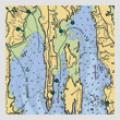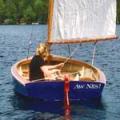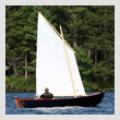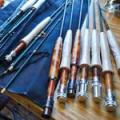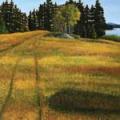In Search of the Biggest Tamarack
 Tamarack trees showing off their fall color. Photo courtesy Kevin Martin
Tamarack trees showing off their fall color. Photo courtesy Kevin Martin
Tamarack trees (American larch) are known for their beauty in the wild and as a landscaping conifer that changes with the seasons. Their soft golden glow in the fall catches your gaze and, in the spring, their bright green needles contrast with young female cones that start off as small purple flowers. Its lumber is used for outdoor applications, where it lasts for some time as posts, decking, and outdoor furniture.
Another important use is as knees in boatbuilding. The tree grows in cold northern swamps, making it easier to pull the large roots from the loose soil once the tree is cut. Over history, some loggers and sawyers made extra money by removing these stumps from swamps and sawing them into knees for wooden boats large and small. The grain follows the curves needed for ribs or stems in Adirondack guideboats, canoes, and the ceiling knees on large ships. Many small boats made by Old Town Canoe Co. before the 1950s feature hackmatack, as the tamarack is called in Maine, for transom and seat knees. The wood is fairly light, smooth to the touch, has a nice blond color, and is hard enough to hold fastenings well. It is also full of resin, which makes it very long lasting.
 The frame for an Adirondack guideboat with hackmatack knees cut to shape for ribs and stems. Photo courtesy Kevin Martin
The frame for an Adirondack guideboat with hackmatack knees cut to shape for ribs and stems. Photo courtesy Kevin Martin
The tamarack has a special place in my mind as a significant tree in the northeast, with a story that shows how connections between people and trees live on in many different ways.
The story starts with the news of a record big tamarack in the NH Big Tree Program that was close in size to the national champion for the species. It had not been located or measured for many years. Coos County forester Brendan Prusik, recently retired Coos forester Sam Stoddard, and I set out and searched for it in a vast swamp area off Bog Brook near the Androscoggin River. After much traipsing around, following moose trails in the knee-deep wet bog, we found several large standing dead tamaracks, and decided the big tree might have been one of those. On the way out we found a smaller living one and declared it the new county champion of the species, but it was not close to the size of the fabled national champion.
A year or so later, Karen Zale from upstate Vermont contacted me about restoring her father’s canoe—he had died a year earlier. She mentioned that its name was Tamarack. I let her know that I would be able to do the work, and thought it was interesting that the canoe was named Tamarack because I had been searching for a large tree of that type.
In a lengthy reply she shared stories of canoeing during childhood and how her father had loved the tamarack tree. She had also attached a story about her father, John Zale. A prisoner of war in the Philippines during World War II, he had survived the Bataan Death March. Afterward, he was aboard what were called the “Hell Ships” that transported the prisoners to a prison camp. The conditions while en route were hellish. Allied battleships fired upon and sank some of the ships, not knowing the prisoners were on board, and more than 1,000 men were jammed into a hold made for 200. Many died but Zale survived, making it to a POW camp in Japanese-controlled Manchuria in northeastern China where he survived three years of torture and harsh treatment. After the war, he returned to Vermont, started a family, and eventually became a Boy Scout leader where he taught the scouts the art of survival.
I was able to restore the canoe to its former glory. The decks turned out to be made of tamarack, and that name was repainted on the sides along with his POW number. Tamarack is now hanging in a Scout lodge in Buffalo, New York. Karen’s book about her father—called The Will to Survive—is available online and through bookstores.
Not long after restoring the canoe, I learned about a large tamarack in Tamworth, New Hampshire. We spent a few hours taking the measurements and admiring the tree. When adding up the circumference, height, and crown spread, the total points earned this tree the title of state champion for New Hampshire, just six points lower than the national champion. At the time, trees within five points of each other were considered a tie. Needless to say, we took a few more measuring trips to that tree, but could never come up with that additional point to make it a national champ.
We submitted it to American Forests as a national competitor. The following year the other champion tree died, and as a fitting end to this story, the NH tree was designated the national champ.
Kevin Martin builds small boats in Epping, New Hampshire. He is the author of Big Trees of Northern New England, published in 2022, which features hikes to visit some of the largest trees on public land.
Related Articles
Share this article:
2023 Maine Boat & Home Show

Join Us for the Maine Boat & Home Show!
Art, Artisans, Food, Fun & Boats, Boats, Boats
August 11 - 13, 2023 | On the waterfront, Rockland, Maine
Click here to pre-order your tickets.
Show is produced by Maine Boats, Homes & Harbors magazine.









